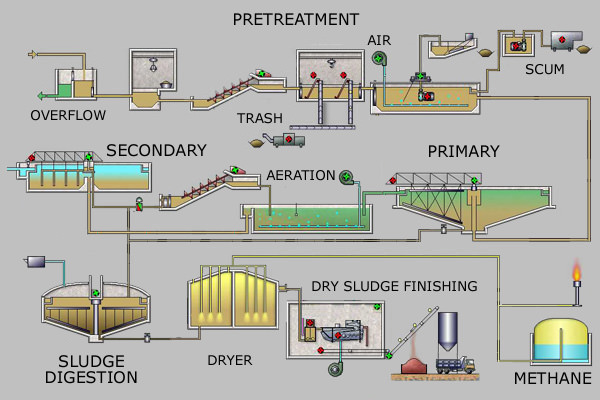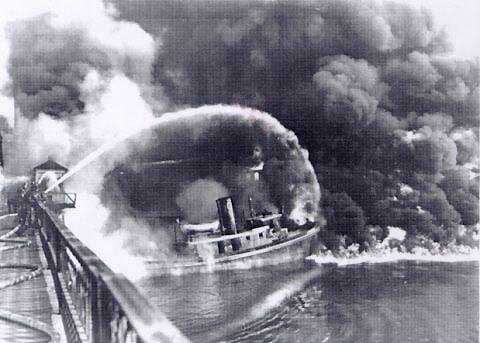8.3 Strategies for Reducing Water Quality Impacts
Strategies for Reducing Water Quality Impacts
Water Treatment
Resolution of the global water pollution crisis requires multiple approaches to improve the quality of our fresh water and move towards sustainability. The most deadly form of water pollution, pathogenic microorganisms that cause waterborne diseases, kills almost 2 million people annually in underdeveloped countries. The best strategy for addressing this problem is proper sewage (wastewater) treatment. Untreated sewage is a major cause of pathogenic diseases and a major source of other pollutants, including oxygen-demanding waste, nutrients (N and P, particularly), and toxic heavy metals. Wastewater treatment is done at a sewage treatment plant in urban areas and through a septic tank system in rural areas.
The main purpose of sewage (wastewater) treatment is to remove organic matter (oxygen-demanding waste) and kill bacteria. Special methods also can be used to remove nutrients and other pollutants. The numerous steps at a conventional sewage treatment plant include pretreatment (screening and removal of sand and gravel), primary treatment (settling or floatation to remove organic solids, fat, and grease), secondary treatment (aerobic bacterial decomposition of organic solids), tertiary treatment (bacterial decomposition of nutrients and filtration), disinfection (treatment with chlorine, ozone, ultraviolet light, or bleach to kill most microbes), and either discharge to surface waters (usually a local river) or reuse for some other purpose, such as irrigation, habitat preservation, and artificial groundwater recharge (Figure 1).

The concentrated organic solid produced during primary and secondary treatment is called sludge, which is treated in various ways, including landfill disposal, incineration, use as fertilizer, and anaerobic bacterial decomposition, done without oxygen. Anaerobic decomposition of sludge produces methane gas, which can be used as an energy source. To reduce water pollution problems, separate sewer systems (where street runoff goes to rivers and only wastewater goes to a wastewater treatment plant) are much better than combined sewer systems, which can overflow and release untreated sewage into surface waters during heavy rain. Some cities, such as Chicago, Illinois, have constructed large underground caverns and used abandoned rock quarries to hold storm sewer overflow. After the rain stops, the stored water goes to the sewage treatment plant for processing.
A septic tank system is an individual sewage treatment system for homes in typically rural settings. The basic components of a septic tank system (Figure 2) include a sewer line from the house, a septic tank (a large container where sludge settles to the bottom and microorganisms decompose the organic solids anaerobically), and the drain field (network of perforated pipes where the clarified water seeps into the soil and is further purified by bacteria). Water pollution problems occur if the septic tank malfunctions, usually when a system is established in the wrong soil type or maintained poorly.

For many developing countries, financial aid is necessary to build adequate sewage treatment facilities. The World Health Organization estimates an estimated cost savings of between $3 and $34 for every $1 invested in clean water delivery and sanitation. The cost savings are from health care savings, work and school productivity gains, and prevented deaths. Simple and inexpensive techniques for treating water at home include chlorination, filters, and solar disinfection. Another alternative is to use constructed wetlands technology (marshes built to treat contaminated water), which is simpler and cheaper than a conventional sewage treatment plant.
Bottled water is not a sustainable solution to the water crisis. Bottled water is not necessarily any safer than the U.S. public water supply. It costs, on average, about 700 times more than U.S. tap water, and every year it uses approximately 200 billion plastic and glass bottles that have a relatively low rate of recycling. It uses much more energy than tap water, mainly in bottle manufacturing and long-distance transportation. If you don’t like the taste of your tap water, then please use a water filter instead of bottled water!
Reduce water usage
The key to lowering the negative impact on water quality from agricultural activities is to decrease the number of contaminants leaving farming operations. This can be achieved by either decreasing what is running off the landscape or decreasing what is put on the landscape to begin with. The main way to decrease agricultural runoff and contamination is to control irrigation water use. Decreasing excess water put on the landscape means runoff will decrease. Using an irrigation technique that is more water efficient will reduce irrigation water needs. Having healthy soil by using cover crops and conservation tillage will keep soil moisture higher and growing crops with water needs that more closely match the areas climatic conditions also lead to less need for irrigation water.
More technologically advanced water management techniques, such as using satellite data to predict rainfall events or using soil moisture monitoring probes can help farmers decide when and how much water to irrigate with. In addition, the timing of when irrigation occurs can help increase infiltration to the root zone and decrease immediate evaporation. Watering in the early morning or later afternoon/evening instead of during the peak heat of midday will reduce water lost to evaporation.
Any technique that reduces water usage will reduce the amount of soil, nutrients, manure, fertilizers, pesticides, and pathogens that run off agricultural fields.
Reduce open soil areas
In addition to keeping soil healthy and able to retain moisture, cover crops also help hold the soil in place. Open soil without roots is far easier to erode than soil being held in place by a robust root system. If open soil is a result of overgrazing, farmers can work to reduce this by actively planting cover crops, reducing tillage, promoting revegetation, and better managing grazing activities by keeping herds smaller or rotating grazing fields on a more regular basis.
Riparian buffers
A riparian buffer (or stream buffer) is a vegetated strip of land beside a stream that helps protect the stream from surrounding land use (Figure 3). These buffer zones intercept and filter out contaminants (nutrients, pesticides, soil, etc.) from agricultural runoff water and prevent them from entering the stream. There are several added benefits of riparian buffer zones. They stabilize eroding stream banks as sediment is held in place by the large root systems of the trees and shrubs. They also provide migration corridors and habitat for animals displaced by agricultural land.

Feedlot management
The buildup of manure and urine in feedlots is a concentrated source of pathogens that must be managed properly to keep it from harming waterways. Properly designed and managed feedlots will collect all runoff that interacts with animal pens, including water used to clean pens, often into an initial sedimentation basin where the solid manure will settle out, and can then be applied to farm fields as fertilizer. The remaining liquid waste will flow out of this basin and either into a holding pond or a discharge area (Figure 4). If a sedimentation basin is not part of the feedlot design, runoff water will flow directly from pens into the holding ponds or discharge areas. A holding pond stores the liquid waste, which is high in nitrogen, and ranchers use this to water crops being grown to feed the animals (Figure 5). If the water is discharged, it is sent to a specially designed discharge area that is often seeded with grasses that quickly take up the nitrogen rich waters so as not to allow excess nutrients to enter waterways or infiltrate groundwater.


Other general design requirements for feedlots include diverting all other surface runoff away from animal pens and establishing feedlots away from surface water bodies.
Nutrient application management
Nutrient application is the general terminology for the application of added nutrients, mainly nitrogen and phosphorous, which are the major components in fertilizers and manure and vital to plant growth. As a general rule, any methods that lead to healthy soil, including cover crops and conservation tillage, help soil maintain appropriate nutrient levels.
For active application of nutrients, monitoring the nutrient levels present in soils and applying nutrients in the form of fertilizer or manure at appropriate levels and only when needed minimizes excess nutrients running off the landscape. Plants also need different amounts of nutrients at different points in their life cycle, so matching nutrient application amounts with life cycle stage is another key component in application management.
As previously discussed, different crops have different nutrient needs and some crops, like legumes, are nitrogen fixers. Utilizing cover crops that are nitrogen fixers will naturally introduce and keep nitrogen in the soil, decreasing the need for nutrient application. Because of the different nutrient needs of plants, if a single plant type is consistently grown in the same field (called monoculture) it will decrease certain nutrients in the soil over time leading to an increased need for fertilizers to get the same amount of crop yield from a field. Using a schedule of crop rotation, where farmers grow a series of different crops on the same field through a sequence of growing seasons, reduces soil nutrient depletion and suppresses weeds and harmful pests leading to decreased nutrient and pesticide application.
Regulations
During the early 1900s, rapid industrialization in the U.S. resulted in widespread water pollution due to the free discharge of waste into surface waters. The Federal Water Pollution Control Act of 1948 was the first act demonstrating U.S. federal government attention to clean water. It established funds for state and local governments to assist them in addressing water pollution issues. At the time, water pollution was seen as a more local, not federal issue, so this act did not set any federal goals or guidelines for how water pollution should be handled. The federal government did not enforce any contamination limits unless the pollution was in interstate waters (i.e., rivers that cross over state boundaries).
Clean Water Act

Over the next few decades, public awareness and concern over water pollution grew, leading to major revisions of the Federal Water Pollution Control Act. The Cuyahoga River in northeast Ohio caught fire numerous times, including a famous fire in 1969 that caught the nation’s attention. In 1972 Congress passed one of the most important environmental laws in U.S. history, the Federal Water Pollution Control Act, more commonly called the Clean Water Act. The purpose of the Clean Water Act and later amendments is to maintain and restore water quality, or in simpler terms, to make our water swimmable and fishable.
The Clean Water Act (CWA) created a basic structure for regulating the discharge of pollution into U.S. water and gave the Environmental Protection Agency the authority to implement and enforce pollution control programs and water quality standards in all waters, not just interstate waters. The CWA made it illegal to discharge a pollutant from a point source into navigable waters unless a permit was obtained. The CWA greatly reduced the amount of pollution entering U.S. water from point sources. More progress is needed because currently, the EPA considers over 40,000 U.S. water bodies as impaired, most commonly due to pathogens, metals, plant nutrients, and oxygen depletion.
The one drawback of the CWA at the time was it very clearly established regulations and requirements for point source pollution but did not address nonpoint source pollution. It is estimated that 40% of all impaired waters in the U.S. are affected only by nonpoint source pollution, while only 10% are affected by only point source pollution. The remaining 50% are affected by a combination of pollution sources. The diffuse nature of nonpoint pollution makes identification and enforcement difficult. Another concern is protecting groundwater quality, which federal law has not addressed sufficiently.
Attribution:
This section is cloned from Environmental Geology, by Lindsay J. Iredale, Normandale Community College, published using Pressbooks, under a CC BY-NC.SA 4. (Attribution-NonCommercial-ShareAlike 4.0 International; https://creativecommons.org/licenses/by-nc-sa/4.0/) . It may differ from the original.
Media Attributions
- feedlot management
